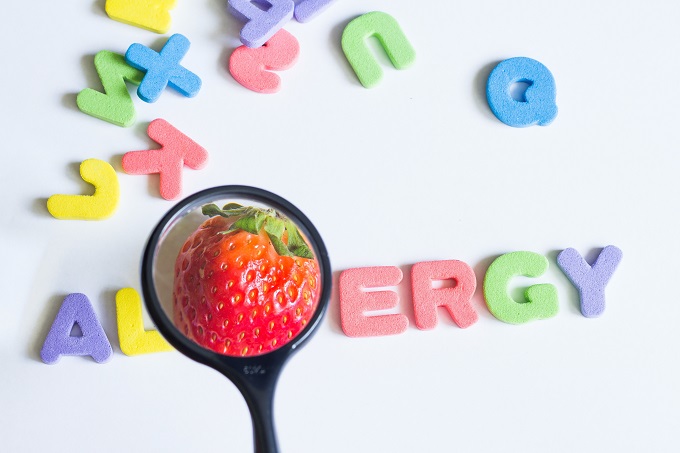
<h2>Food allergy can have a considerable impact on anxiety levels for students and their families, particularly when they start a new school.</h2>
<p>This can be alleviated by having clearly stated policies and procedures focussing on safety as well as full participation for the student.</p>
<p>Food allergy is a health condition that seems to have crept up on us in recent decades. It was considered rare prior to the 1990s but is now described as a common condition in early childhood. One-in-ten infants are likely to have a food allergy by the time they reach 12 months. Fortunately, many will out-grow their milk and egg allergies (two of the most common food triggers) and the latest data indicates that prevalence reduces to around five percent of 10 to 14-year-olds. The main food triggers in this age group are peanuts, tree-nuts, fish and shellfish, which tend to persist for life. Some adolescents may also have unresolved milk, egg, soy or wheat allergies.</p>
<h3>Other food allergies common in New Zealand include sesame and kiwifruit.</h3>
[pro_ad_display_adzone id=&#8221;4703&#8243; align=&#8221;left&#8221;]
<p>Many people report problems with food these days and it is often hard to distinguish between food allergy and food intolerance. The main reason for the focus on food allergy and the need for it to be managed appropriately in schools is that it is potentially life-threatening. Food allergic reactions usually happen within minutes of ingesting the food and if symptoms progress to affecting breathing, or the cardio-vascular system, (a severe reaction known as anaphylaxis), an emergency response is required. Getting the person to lie down, administering an intra-muscular injection of adrenaline (using an <em>EpiPen</em>) and dialling 111 for an ambulance are the essentials.</p>
<p>Food intolerances, on the other hand, do not cause life-threatening symptoms, and symptoms are often delayed and/or dose-responsive, unlike food allergy where even a small amount ingested can cause an allergic reaction.</p>
<p>Most food allergies emerge in early childhood as children are introduced to solids. If food allergy is suspected, children should be referred to a specialist or paediatric department at their local hospital for confirmation of the diagnosis, clinical management and on-going monitoring. As part of this they should be assessed for their risk of anaphylaxis and given an <em>Allergy or Anaphylaxis Action Plan</em> signed by their doctor. If at risk of anaphylaxis, two adrenaline auto-injectors e.g. <em>EpiPens</em>, are usually recommended, one for home and the other for school (note that these are not funded by PHARMAC).</p>
<p>There is no cure or treatment for food allergy, and the only way to manage it and prevent reactions, including anaphylaxis, is to completely avoid the food. It is therefore vital for schools to have policies and procedures in place which support the child or young person to manage their food allergy safely, and at the same time ensure staff and volunteers know how to respond if an accident (anaphylaxis) happens.</p>
<p><strong>There are six key steps in reducing the risk of anaphylaxis:</strong></p>
<ol>
<li>Have questions on the enrolment form that will identify students at risk of anaphylaxis. Ask the parent/caregivers to provide up-to-date medical information including a copy of their child’s <em>ASCIA Anaphylaxis Action Plan</em> signed by their doctor. Develop a health-care plan, including decisions on where the <em>EpiPen</em> should be kept. Update annually.</li>
<li>Ensure all staff have training in recognition and management of acute allergic reactions; know the students at risk, and where their <em>EpiPen</em> is kept.</li>
<li>Be aware that unexpected allergic reactions might occur for the first time outside of home in those not previously identified as being at high risk, e.g. on a school trip where a student has anaphylaxis to a bee or wasp sting.</li>
<li>Age appropriate education of children with severe allergies and their peers, to help minimise risk, reduce bullying, and increase <a class="wpil_keyword_link" href="https://www.schoolnews.co.nz/2015/10/developing-opportunities-at-school-with-a-view/" title="opportunities" data-wpil-keyword-link="linked" target="_blank">opportunities</a> for socialisation and participation for students with food allergies who otherwise tend to miss out.</li>
<li>Implementation of practical strategies to reduce the risk of accidental exposure to known allergic triggers. Banning of foods such as peanuts is not recommended as it is difficult to enforce and there is no evidence it reduces risk. A review of risk minimisation strategies can be found at <a href="http://www.allergy.org.au" target="_blank">www.allergy.org.au</a>.</li>
<li>Consider institutional provision of AAIs (e.g. <em>EpiPen</em>) for general use. <em>EpiPens</em> in first aid kits could be used as back-up devices for students who may need more than one injection of adrenaline in case of a severe reaction and/or a remote location, e.g. school camp.</li>
</ol>
<p><em>Information and resources for schools are available online via Allergy New Zealand or the Australasian Society of Clinical Immunology and Allergy (ASCIA). This includes links to free on-line training, and resources developed under the Australian National Allergy Strategy (a federal government-funded project). One of these is ‘250k’, a hub for young people with food allergies. </em></p>

EXCLUSIVE: Teachers used to be paid two to three times more than minimum wage workers,…
After an “overwhelming” vote to reject the latest Government offer, secondary school teachers will begin…
Second-language learning should be compulsory, says a new report from a forum bringing together academics,…
A new entitlement aimed to improve access to learning support coordinators for schools with students…
Educators have raised questions about the Ministry of Education’s new secondary school subjects, set to…
Professional learning and development (PLD) for teachers needs to be higher impact for teachers and…
This website uses cookies.